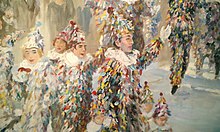István of Somogyi
István von Somogyi (born September 4, 1894 in Ógyalla , † 1971 in Budapest ) was a Hungarian painter .
Life
He studied art at the Hungarian Academy of Fine Arts in Budapest . From 1914 to 1916 he served as a lieutenant in the Hungarian Army. He later worked in Germany as a painter in Bad Soden , Buchen (Odenwald) and Bödigheim .
Somogyi became famous for his dynamic images of horses.
After studying in Budapest, he became known for two portraits, namely that of the imperial administrator Miklós Horthy and that of Otto von Habsburg . However, his great preference was horses. Horse representations and animal studies made him famous in his homeland. From 1930 he had his first exhibitions. His paintings can also be found in the Museum of Fine Arts, Berlin. In 1937 he settled in Germany. After the end of the Second World War, he came to Bödigheim in 1947. Until his death in 1971, von Somogyi had many contacts with personalities from the arts and culture. Among other things, Oskar Kokoschka stayed with him in Bödigheim as a guest.
Between 1965 and 1966 he created a wall mosaic of around 30 m² in the Frankenlandhalle in Buchen. The artwork was completed on April 20, 1966. It consists of around a million colored Italian glass and Japanese porcelain stones, cut by hand. István von Somogyi and his wife Liselore von Somogyi used around a hundred different colors for the mosaic. The mosaic shows, among other things, the portraits of Buchen’s personalities, for example that of the then President of the Carnival Society of Buchen, Kurt Hemberger .
The mosaic was ceremoniously unveiled to the public in April 1966. The mosaic was secured in 2009 from the demolition of the old festival hall and reassembled in 2011 in the city hall in Buchen, which was newly built at the same location.
Another mosaic by the artist István and his wife was created in the indoor swimming pool in Seckach .
See also
Web links
- Immortalized almost life-size on the mosaic (PDF; 117 kB)
| personal data | |
|---|---|
| SURNAME | Somogyi, István from |
| BRIEF DESCRIPTION | Hungarian painter |
| DATE OF BIRTH | 4th September 1894 |
| PLACE OF BIRTH | Ógyalla |
| DATE OF DEATH | 1971 |
| Place of death | Budapest |


